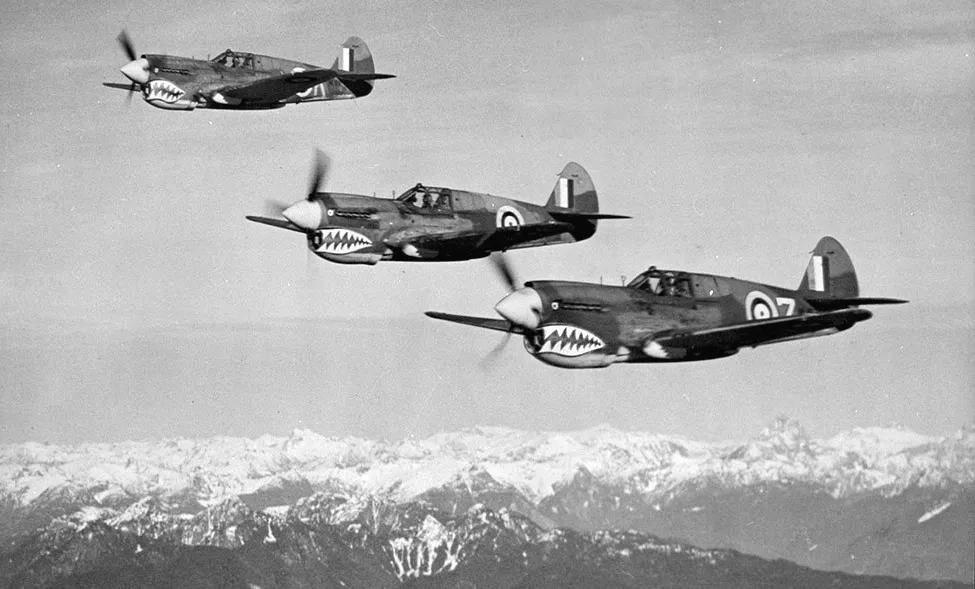Tomahawk (Total: 1,183, Canadian: 15, Group 0)
Curtiss Tomahawk

RCAF Curtiss P-40 Kittyhawks in formation over the West Coast, 11 Nov 1942
The Curtiss P-40 (known as the Warhawk in the USA) is single-engined, single-seat, all-metal fighter and ground-attack aircraft that first flew in 1938. Â The British Commonwealth air forces including the RCAF, and the Soviet air forces used the name Tomahawk for models equivalent to the P-40B and P-40C, and the name Kittyhawk for models equivalent to the P-40D and all later variants. Â The P-40 was in frontline service until the end of the Second World War. Â It was the third most-produced American fighter of the war after the P-51 and P-47, with 13,738 being built in Buffalo, New York. Â Based on war-time victory claims, over 200 Allied fighter pilots from 7 different nations (Australia, Canada, England, New Zealand, South Africa, the Soviet Union and the United States) became aces flying the P-40. Â A total of 13 RCAF units operated the Kittyhawk in the North West European or Alaskan theatres.
In mid-May 1940, Canadian and US officers watched comparative tests of a XP-40 and a Spitfire, at RCAF Station Uplands, Ottawa, Ontario. Â While the Spitfire was considered to have performed better, it was not available for use in Canada and the P-40 was ordered to meet home air defense requirements. Â In all, eight Home War Establishment Squadrons were equipped with the Kittyhawk: 72 Kittyhawk Mk. I, 12 Kittyhawk Mk. Ia, 15 Kittyhawk Mk. III and 35 Kittyhawk Mk. IV aircraft, for a total of 134 aircraft. Â These aircraft were mostly diverted from RAF Lend-Lease orders for service in Canada. Â The Kittyhawks were obtained in lieu of 144 Bell P-39 Airacobras originally allocated to Canada but reassigned to the RAF. Harold A Skaarup Web Page
Tomahawk I serial A314
s/n A314
c/n 14498
A 314
Known Units:
No previous RCAF history. Ex RAF AH793. Damaged while being shipped from the UK to West Africa, diverted to the US, and eventually passed to the RCAF. Used by No. 1 Technical Training School at Aylmer, Ontario. "Residue" retained in a whole state after strike off, pending disposal to War Assets Corporation.last update: 2025-November-19
1943-September-10 Classified Instructional CA A 314 2020-06-16
1946-May-09 Struck off Strength Struck off at Aylmer 2019-08-20
Tomahawk I serial A315
s/n A315
c/n 14545
A 315
Known Units:
No previous RCAF history. Ex RAF AH840. Damaged while being shipped from the UK to West Africa, diverted to the US, and eventually passed to the RCAF. Used by No. 1 Technical Training School at Aylmer, Ontario. "Residue" retained in a whole state after strike off, pending disposal to War Assets Corporation.last update: 2025-November-19
1943-September-10 Classified Instructional CA A 315 2020-06-16
1946-March-30 Struck off Strength 2019-08-20
Tomahawk I serial A316
s/n A316
c/n 14479
A 316
Known Units:
No previous RCAF history. Ex RAF AH774. Damaged while being shipped from the UK to West Africa, diverted to the US, and eventually passed to the RCAF. Used by No. 1 Technical Training School at Aylmer, Ontario.last update: 2025-November-19
1943-September-10 Classified Instructional CA A 316 2020-06-16
1946-September-26 Struck off Strength 2019-08-20
Tomahawk IIA serial A317
s/n A317
c/n 14188
A 317
Known Units:
No previous RCAF history. Ex RAF AH938. Damaged while being shipped from the UK to West Africa, diverted to the US, and eventually passed to the RCAF. Used by No. 1 Technical Training School at Aylmer, Ontario. "Residue" retained in a whole state after strike off, pending disposal to War Assets Corporation.last update: 2025-November-19
1943-September-10 Classified Instructional CA A 317 2020-06-16
1946-March-30 Struck off Strength 2019-08-20
Tomahawk I serial AH747
s/n AH747
AH 747
Known Units: ;400
With No. 400 Squadron, RCAF when it was destroyed on 8 February 1942 in a mid-air with Tiger Moth R4952 at Odiham.last update: 2025-November-19
Tomahawk I serial AH810
s/n AH810
AH 810
Known Units: ;400
With No. 400 Squadron, RCAF when written off on 22 May 1941. Crashed near Gower Peninsula, Glamorgan. Stalled during an attempted forced landing. Flight Lieutenant W.A. Rider killed, was en route to Wales to take part in enquirey into death of a 400 Squadron pilot a few days earlier, while on loan to 225 Squadron, RAF.last update: 2025-November-19
Tomahawk I serial AH818
s/n AH818
AH 818
Known Units: ;400
last update: 2025-December-24
Tomahawk I serial AH865
s/n AH865
AH 865
Known Units: ;400
Used by No. 403 (F) Squadron, RCAF, from March to June 1941, flying training missions from Baginton, UK.last update: 2025-November-19
Tomahawk IIA serial AH889
s/n AH889
AH 889
Known Units: ;400
last update: 2025-December-24
Tomahawk IIA serial AH902
s/n AH902
AH 902
Known Units: ;414
Used by No. 414 (F) Squadron, RCAF, from September 1941, flying training missions from Croyden, UK.last update: 2025-November-19
Tomahawk IIA serial AH919
s/n AH919
AH 919
Known Units: ;41
last update: 2025-December-24
Tomahawk Mk. IIB serial AK416
s/n AK416
AK 416
Known Units: ;250
last update: 2025-December-24
Tomahawk Mk. IIB serial AK530
s/n AK530
AK 530
Known Units: ;250
last update: 2025-December-24
Tomahawk Mk. IIB serial AM454
s/n AM454
AM 454
Known Units: ;1
last update: 2025-December-24
Tomahawk Mk. IIB serial AN344
s/n AN344
AN 344
Known Units: ;250
last update: 2025-December-24

